SIMPLE. PRACTICAL. TRUSTED.
ANIMAL HEALTH SECTION 03


VBP+ PRODUCER REFERENCE MANUAL


SIMPLE. PRACTICAL. TRUSTED.




Animal health is key to a successful beef operation. Good health is a combination of prompt and preventive medical care, proper nutrition, animal care, surveillance and housing.
The use of medications to keep cattle healthy and prevent disease transfer requires diligence to minimize risk of drug residue, antibiotic resistant bacteria and broken needles.
Every VBP+ operation must have a valid and active Vet-Client-Patient-Relationship (VCPR). Veterinarians are an excellent source of information and can provide treatment prescriptions and guidance when animal health issues arise.
Producers are encouraged to work with a veterinarian to create a Herd Health Plan (HHP). The HHP describes steps to protect and maintain cattle health, documents every treatment and ensures that drug residue and broken needle status is available for each animal. On-farm food safety, on-farm biosecurity and animal care/welfare practices are outlined throughout the HHP document.
Each Herd Health Plan will be unique to the beef cattle operation for which it was developed. The plan should include systems for keeping records, documenting treatments and procedures, calculating withdrawal times, steps to be taken if something goes wrong, herd health and performance goals, etc.
Beyond medications, there are other factors that impact herd health such as water, feed, supplements and bedding. Quality of these inputs (and how they are sourced, handled and stored) may impact health, food safety, biosecurity and the environment.
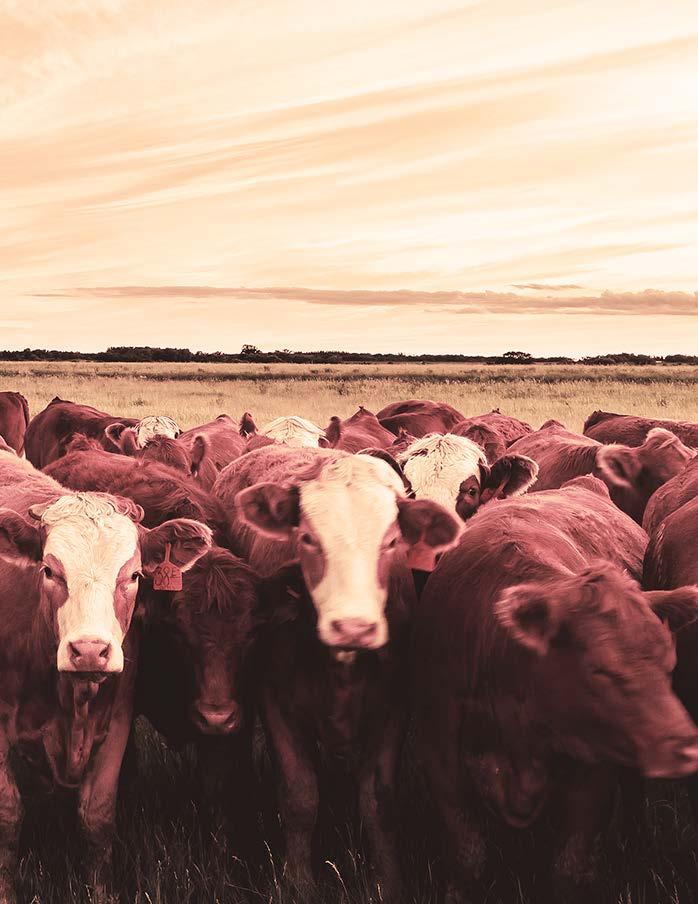
VPB+ producers must capture data for all animal health events, possible exposure to toxins or broken needles, as well as all cattle sales and deaths.

Animal health records should be kept on both an individual and group basis as applicable. For example, some veterinary health protocols for vaccination, parasite control and treatment of cattle may occur by group. In this instance, the record should indicate that the same treatment was given to all cattle within the group. If a group treatment record is utilized, it is important that all animals within that group fall under the same withdrawal period. If an animal was individually treated for an infection or other disease, that record would indicate the treatment details for the specific animal involved. Withdrawal times must be checked prior to shipping animals.
Choose a record-keeping system that works for your operation. Whether it be a software program, computer spreadsheet, paper records, or notes on your phone, the system should be easy to use while effectively capturing vital information. Records should be secure and kept for at least two years. It is also a good idea to take note of where medical prescriptions will be filed, and to have emergency contact information readily available.
As a guide to navigate through VBP+ Certification requirements (if you choose to pursue VBP+ Certification), all of the SelfAssessment topics have been categorized as being either:
VBP+ Standard or VBP+ Required.
PRESCRIPTIONS AND EXTRA-LABEL DRUG USE
TREATMENT RECORD
TREATMENT ERRORS & ACCIDENTAL EXPOSURE
BROKEN NEEDLE RECORD
CATTLE DEATH RECORD
SHIPPING RECORD


VBP+ Standard category represents topics that necessitate an understanding of concept and consideration of record-keeping. A score less than 1 will trigger a Corrective Action Request and a timeline for completion.
VBP+ Requirement category represents topics that are considered Critical Control Point. These are records required for certification. A score of less than 2 will trigger a Corrective Action Request and a timeline for completion.



Under current Canadian legislation, all antibiotics must be purchased from a veterinarian. A veterinarian will write a prescription for the product requested, which can be dispensed at any vet clinic of the producer’s choosing. The vet writing the prescription is required by law to have a valid VCPR with the producer. The clinic dispensing the product does not need a valid VCPR.
All prescriptions, patient notes and veterinary care instructions are to be kept on file for two years. Records should provide evidence that medications are used as instructed.
Regular communication with your veterinarian ensures prescriptions are current and available. Keeping a record of all veterinary prescriptions—including drugs and medicated feed or water— for two years is valuable from both an animal health and food safety perspective. This information can confirm the completion of an animal treatment and prove adherence to drug withdrawal times.
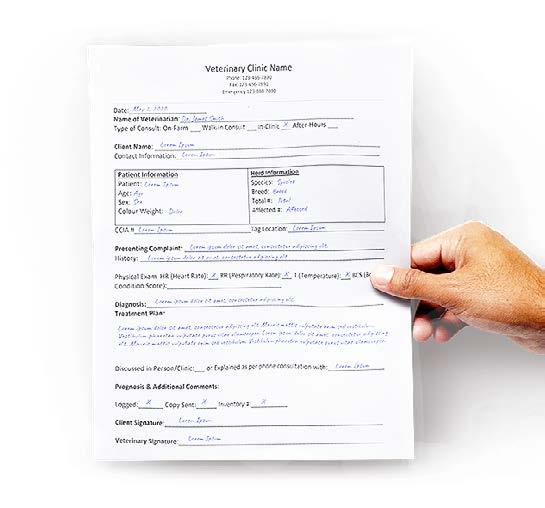
A prescription from a veterinarian includes the product name, what it is used for, label directions or administration instructions, drug identification number (DIN), and withdrawal information .
EXTRA-LABEL DRUG USE (ELDU) or “off-label” use is defined as the utilization of animal health products in a manner that differs from indications on the product label or insert. Veterinarians will sometimes prescribe extra-label use of a product, specifying when and how to use the treatment. Prescriptions for ELDU must be renewed annually, as does a valid VCPR.

WHY IS ELDU A CONCERN? Drugs undergo a long and indepth process to ensure their efficacy and safety under the conditions described by the label. The withdrawal times are known when the drug is used according to directions, but when a drug is used off-label, there is a potential risk that the withdrawal time will be compromised or unknown. In the case where extra-label use is applied as per prescription, the veterinarian will provide guidance on appropriate withdrawal time. This is important for food safety and liability reasons.
Adhering to withdrawal times helps avoid potential residues in meat from cattle shipped for slaughter. This includes, but is not limited to, finished cattle, cull cows and bulls and emergency salvage slaughter (i.e. broken leg).
All written prescriptions for extra-label drug use should be included in a permanent file that is readily accessible. This may be in the form of a written note, an electronic file or picture.
Check the labels on all drugs used for cattle; they should indicate “for veterinary use”, for “livestock use”, or for “cattle use”. Non-prescription animal health products purchased abroad and imported under “own use” guidelines must carry a drug identification number (DIN). The Canadian Compendium of Veterinary Products can be found online and used as a reference if a product label or insert has been lost or is illegible. Banned products are prohibited, and liability falls on the producer if used. When in doubt, contact your veterinarian.

No treatment records and protocols kept, lack of understanding of ELDU, prescription requirements or banned products. Treatment records indicate EDLU no prescription, or banned product being used, or no prescription for purchase or proof of purchase in Canada.
Treatment records and protocols are available but do not contain the required information and indicate ELDU, confusion over the sticker in the product as adequate to cover ELDU, awareness of proper use.
Treatments records and protocols are available and complete. Adequate knowledge of prescriptions and ELDU, Documents provided, willingness to use products appropriately, stored for 2 years.
Provides detailed written treatment protocols, documented policy and procedures for reducing ELDU, written training and use of prescription requirements (any of these criteria).
All treatments given to cattle are documented in a retrievable and sharable format.
A treatment is any use of medication, vaccine, antibiotic, probiotic or supplement which can be administered via injection, feed, water or aerosol.
When documenting a treatment record, the following information must be recorded:
ID of all individual animal(s) or group ID
It is also recommended to include the reason for treatment, identification of the person doing the task (initials or
It is important to link the cattle with their treatment record so that withdrawal times can be calculated, ensuring that cattle are safe to ship without risk of chemical or antibiotic residue. If a product is used “extra-label” it must be covered by a prescription from a veterinarian with a valid VCPR. Some products don’t have a withdrawal time, such as Rumensin or growth implants, however it is still recommended to record the date of administration.
Treatment records can be maintained in various forms: handwritten, in spreadsheets, or using software programs. Regardless of form, treatment records must be available to VBP+ auditors. Templates for group and individual health records are available in Appendix A.
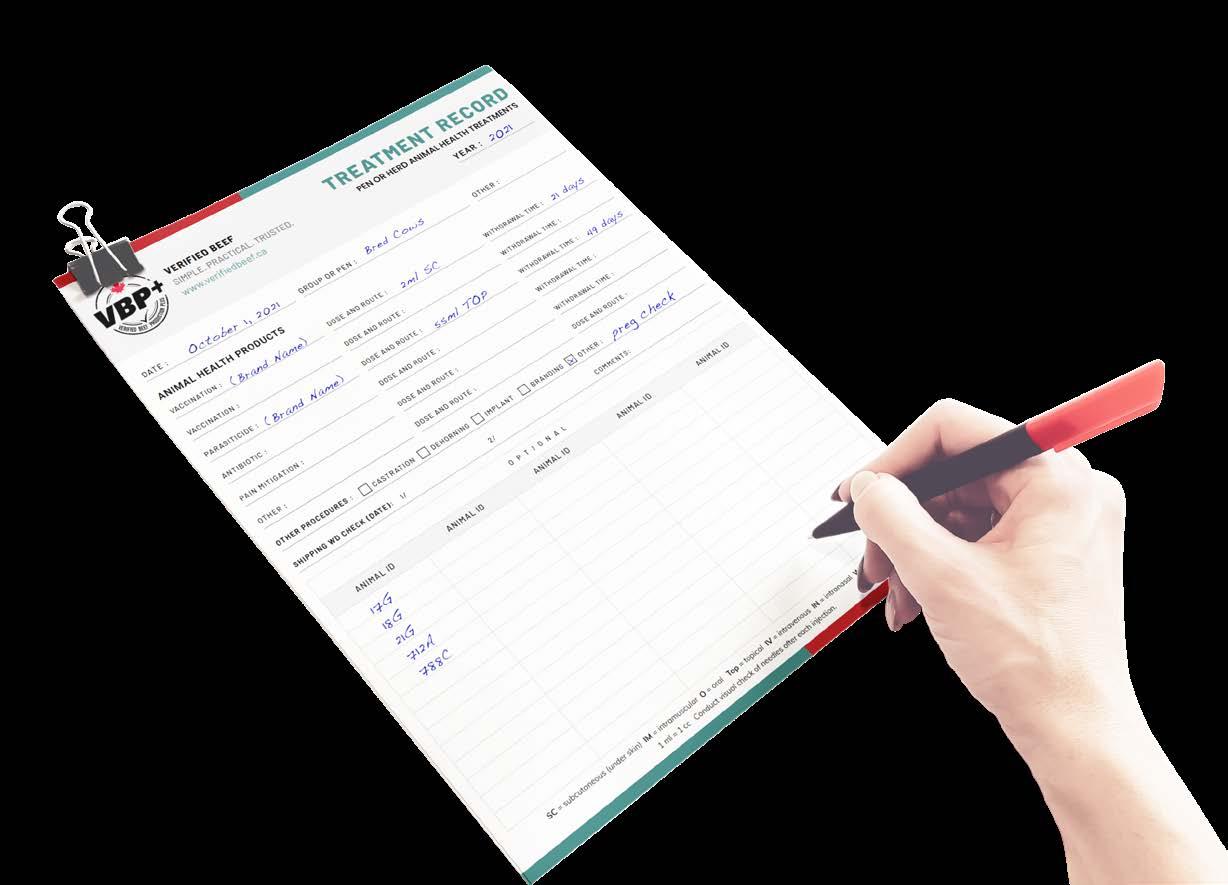

No treatment records are available. Record is inconsistently recorded; date, product, diagnoses, identification, route, withdrawal times, dosage, or obvious ELDU without prescription.
Record is filled out, some small inconsistencies.
Records complete.
Records complete. Veterinarian uses records to adjust Herd Health Plan, product selection and other management criteria; biosecurity.
To ensure food safety, all potential chemical residue risks must be recorded. Animals that may harbour chemical residues must be held for an appropriate time to ensure the residue has vacated tissue prior to slaughter.
Documenting all treatment errors and accidental toxin exposures aids in determining the withdrawal period. Ensure the correct animal(s) are identified, contact your veterinarian for advice, and record what actions are taken.
Errors happen and producers should consider developing procedures for incident reporting. An Incident Report/ Exposure Record can be on paper or electronic device, and should document the following:

Sometimes cattle are subjected to a treatment or exposed to a substance in error. For example, a treatment mistake could involve the wrong product, incorrect dosage, use of an expired product or unintentional ingestion of medicated feed or water.

Exposure to potentially toxic substances could occur in various situations: through accidental inclusion in feed or water, introduction to forage/pasture/range treated with pesticides, ingestion of feedstuffs intended for other species or exposure to hazardous material due to improper storage or unforeseen livestock access. Think about situations that may result in a food safety issue, such as ingesting antifreeze, licking lead batteries, petroleum spills, drift from crop sprayers or cattle getting loose.
Lack of understanding of the implication and significance of a treatment error or unidentified toxin exposure.
Awareness of the implication and significance of a treatment error or unintended toxin exposure.
Aware of the implication and significance of a treatment error or unintended toxin exposure and can respond to the incident and can articulate their response to an incident. Have record of incident if occurred.
Operations has documented protocols and training for a treatment error or unintended toxin exposure, with record of incident if occurred.
Animal or herd ID
Type of exposure/error
Date of exposure/error
How animal exposed to toxin
Duration of exposure
Veterinarian advice (treatment details, expected withdrawal time)
Actions taken to avoid a repeat occurrence/error in future

All incidents involving a broken or missing needle must be recorded in a format that can be retrieved and shared, in order to prevent an animal with a suspected or actual broken needle from entering the food chain.
A broken needle retained in an animal is a serious food safety risk. It is rare, but needle fragments in beef cuts have been reported at the consumer level. This is a situation under the control of animal managers – accidents may happen, but they must always be recorded and dealt with in an appropriate manner so that the foreign body does not enter the food chain.
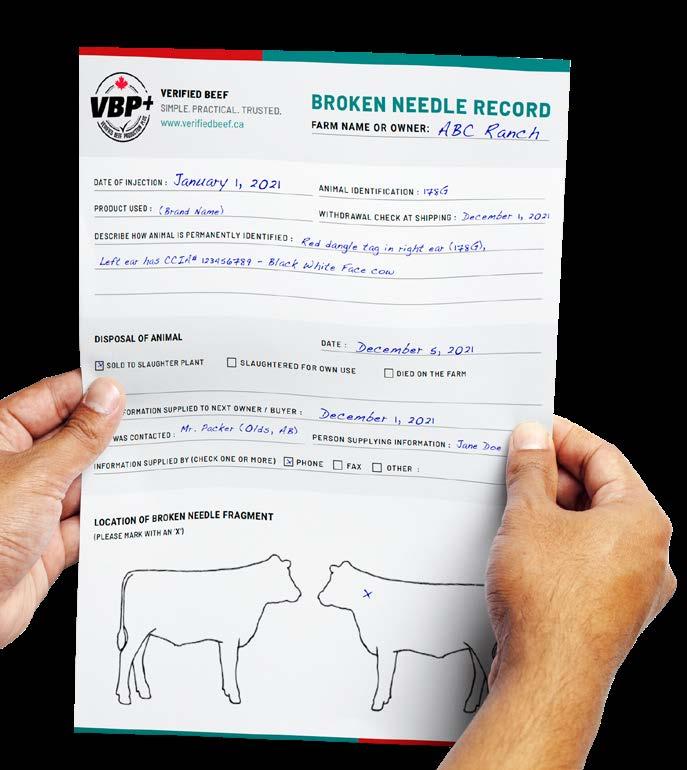
Identify the animal involved, preferably cross-referencing to its CCIA tag, and record the incident in your permanent records. Share this information with any future owner of the animal, or if the animal is transported to another location under the care of someone else. Documentation of broken-needle status should appear on any transfer of ownership or management certificates, receipts, invoices, manifests, etc. If this is not possible, the animal should be euthanized or slaughtered for personal use.
After every injection, the needle should be checked to ensure no part of it has broken off. This includes the use of remote delivery devices, such as dart guns. If the needle or dart is broken or missing, it must be recorded that the animal may contain a broken needle. Why? To prevent an animal with a suspected or actual broken needle from entering the food chain; and uphold consumer standards for safe, quality beef.
Broken or suspected broken needle records must be accessible and referenced at all shipping events, and should include:
Date
Permanent Animal ID
Location of suspected broken needle on the animal
Type of needle

Plan/protocol for how the animal will be used/marketed
Procedure for how animal will not be missed when shipped
Withdrawal time listed as the life of the animal
Lack of understanding of broken needle protocol and unable to articulate how to respond in the event of a broken needle. No documentation (SOP or records available on the operation).
Operation understands how to implement broken needle process, however, does not have documentation to support process or records are incomplete.
Operation understands how to implement broken needle process and had documentation in place. Although operation may never had a broken needle in operation, process is in place.
Record in place, incidence investigated, mitigation implement, animal disposed of without entering the food chain (all documented), training records.
All cattle death events should be documented in a format that can be retrieved and shared.

Recording animal deaths and their cause is important from an animal health and biosecurity perspective. If a death is suspected or confirmed to be from disease, further management steps may be necessary to protect other animals or people from a potential health risk. Deaths from injury or mishap may indicate that a different set of management practices (i.e.: handling or transport procedures) would be beneficial. If euthanasia is required, this record may also help producers identify areas where animal welfare can be improved.
Deaths and euthanasia records should include:
Date
Animal ID
Cause of death (if known)
Location of animal when death occurred (pasture, home pen, sick pen, chronic pen)
Was a post mortem/necropsy performed?

If so, by whom?
Producers should be knowledgeable about biosecurity implications of dead stock disposal, which are covered.
0
1 2
Operation has limited knowledge of requirement of death records and limited knowledge of animal euthanasia protocol
Operation can articulate animal euthanasia protocol and are aware of possible biosecurity concerns. Death and Euthanasia records are kept and available for review.
Operation has written animal euthanasia and deadstock protocol(s). Records are used for analysis and investigation of deaths.
A shipping record is a document that serves as a checklist that 3 essential record validations have been made: withdrawal date, broken needle and fitness for transport.
The shipping record documentation will follow cattle with transfer to new ownership. It can be any document that includes the date and ID of animals being shipped plus verification that all of the following records have been checked :
Withdrawal Date(s)
Broken Needle Record(s)
Fitness for transport evaluation has been performed
Transportation is a CRITICAL CONTROL POINT in the on-farm food safety chain and is reviewed in detail within Section 07-Transportation of the VBP+ Producer Reference Manual. A template for shipping records is also provided in Appendix A in Section 8 of this manual.
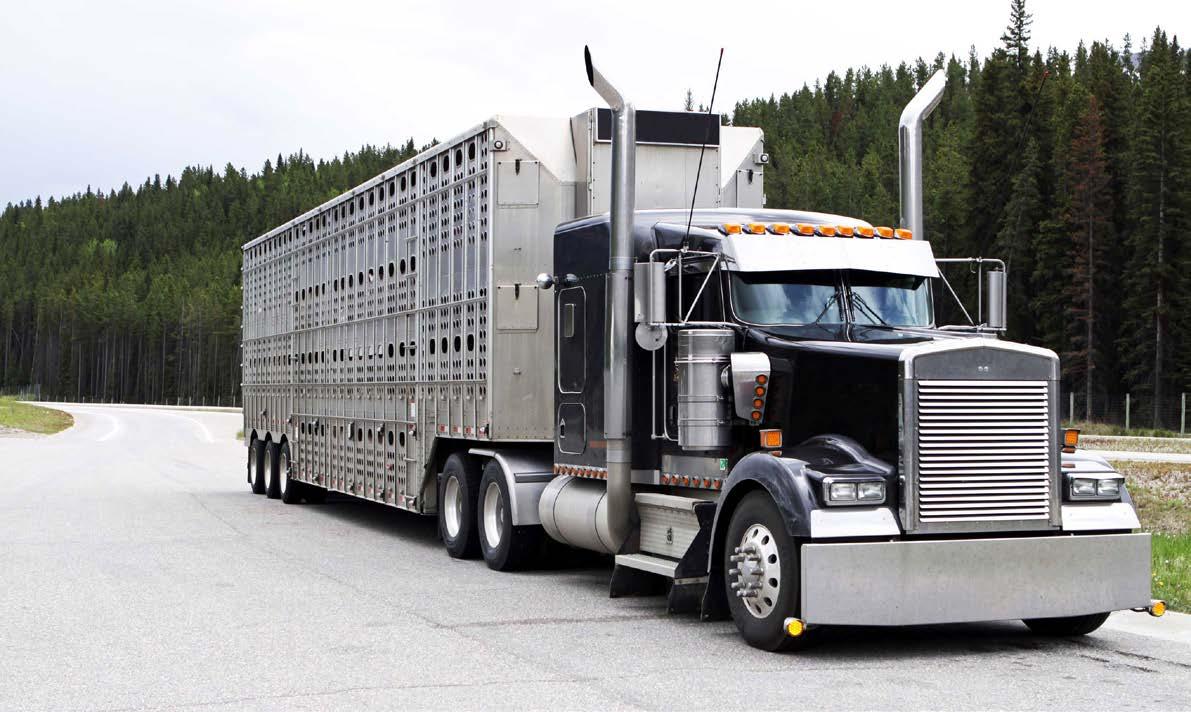
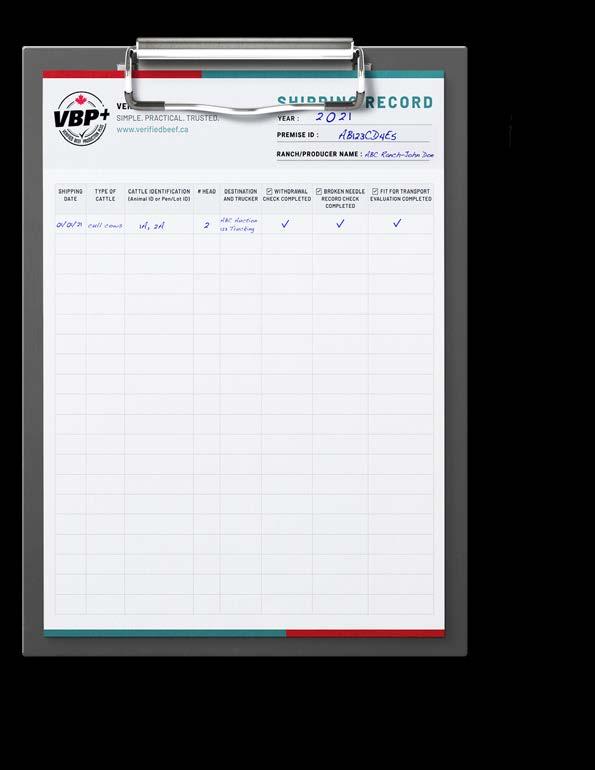
Lack of understanding or awareness of either the need for a withdrawal check, broken needle check and fitness for transport evaluation or a record to show check has been performed.
Awareness of the need for pre-shipping checks and fitness for transport evaluations but no process for records check; next owners not informed of withdrawal times or possible broken needles.
Shipping records present but inconsistent validation of record checks and/or fitness for transport evaluations performed; potential food safety issues communicated to next owners.
Shipping records complete and consistently validated; withdrawal times respected and next owners consistently made aware of potential food safety issues. Fitness for transport evaluations.

Our family has been farming for generations. I plan to make it better for the ones to come. Our relationship with our veterinarian is a key tool in maintaining our herd health and helped introduce us to VBP+.

Resources like toolkits and record templates are available for producers to use, together with their veterinarian, to demonstrate the good practices used on-farm. Check them out at verifiedbeef.ca.
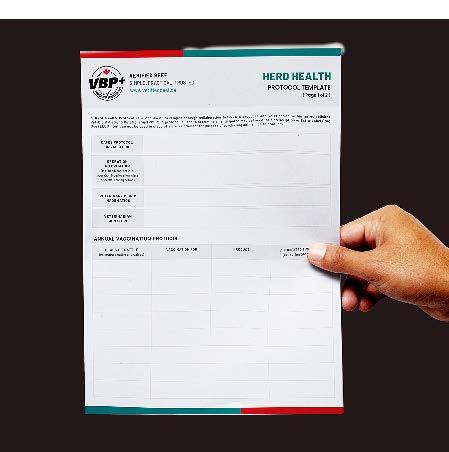
.
#myvbpstory
How does your relationship with your veterinarian help your beef operation?
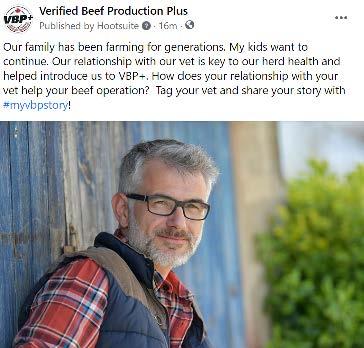
Share with #myvbpstory

ANIMAL HEALTH PRODUCTS


ANIMAL HEALTH EQUIPMENT


All animal health products and equipment are stored and used according to label directions.
Animal health products such as vaccines, medications and topical treatments must be stored according to the label directions. This is to make sure the product remains stable and effective for the intended use and purpose. Products vary in their storage requirements; access to refrigeration and the absence of sunlight for some products is necessary. This is important not only for storing product in the office/ barn, but also when you are transporting product for use in the field, where it may sit for hours before use. Improper storage could lead to altered withdrawal times and chemical residues in cattle, or reduced product effectiveness.
Storage areas for animal health products need to be organized, with all product labels clearly readable. If the labels become illegible, make a copy of the product label insert and post it in an area where people can access it. By doing so, you minimize the risk of administering the wrong product. If you have other species on the premise, make sure you segregate all products for those animals from your cattle products. Keep them separate from the bovine products by using a separate shelf or a container clearly marked, “not for use in cattle”.
Keep vaccines cool and away from direct sunlight. In the field, medications should be kept in portable coolers near your processing facilities for easy access. Don’t leave medications in uncontrolled environments such as vehicles with excess to sunlight or extreme heat or cold.
Pay attention to the information for usage and expiry dates on all products. Once opened, some products may not be stored for further use. Compromised or expired animal health products should be disposed of in a manner that will not contaminate cattle feed or water, nor pose a risk to environmental or human safety. Follow label directions for safe disposal or talk to your veterinarian for advice.
Consider keeping an animal health product inventory record to log when animal health products were acquired and when they expire. These initiatives assist in preventing antimicrobial resistance, while providing the most efficacious and least expensive prevention and treatment of disease.
Little regard for correctness; storage not suitable (i.e. fridge is not working); expired or banned product present.
Most of checklist is addressed; implementation partially achieved.
Adequate across all checklists, storage for empty drug bottles and sharps.


Keeps animal health product inventory exceptionally clean, tidy, and organized; storage for empty drug bottles and needles; written plan for disposal, everything in its place.
Expired drugs culled
Refrigerator working correctly (use of thermometers preferred, min/max indicator ideal)
Storage is appropriate for products present (dark, cool, etc.)
Products clearly stored as per species (i.e. no horse products with cattle products)
No banned products present
Products organized to reduce treatment errors
No needles stored in bottle tops
Facility clean to avoid contamination
Empty drug containers stored for appropriate disposal
Package inserts or dosage protocols available; access to a drug compendium
Animal health product inventory summary available
Method to determine animal weights (scale, body tape or reasonable estimate)
Spent needles collected and disposed in an appropriate manner

Animal health products are most effective when they are used with proper attention to the dosage, route of administration, accuracy and cleanliness of the equipment. Equipment used to distribute animal health products should be clean, calibrated and precise so withdrawal times can be accurately predicted. Appropriate needle selection places product in desired location to provide optimum efficacy and minimum tissue damage. Secure restraint of animals minimizes broken needles and provides a safe environment for cattle and people.
Equipment such as oral dosing guns, pour-on applicators, and multi-dose syringes must accurately deliver the proper dosage. Multi-dose syringes can be tested by drawing a specific amount of water (i.e. 10 cc/ml), then using a specific setting (i.e. 2cc, 5cc) to ensure the doses are released accurately. Equipment should be tested regularly, prior to use.
Mixing two or more products in the same syringe is NOT acceptable; unpredictable withdrawal times, meat quality issues (abscesses), unnecessary pain to the animal and other unintentional side effects are possible.

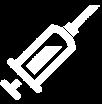
The equipment used to deliver animal health products must be cleaned regularly and correctly. Syringes should only be cleaned with hot (not boiling) water, then allowed to air dry. A syringe with leftover medication or cleaning agent residue could destroy some vaccines and contaminate the next product used. For example, vaccines containing formalin may interfere with the efficacy of other drugs. It is best practice to use separate or designated multidose syringes for vaccines and antibiotics. (Proper steps for disinfecting other animal health tools are described in Section 8: Biosecurity.)
Most product dosage will be determined by the weight of the animal. An on-farm scale is the most accurate method to assess weight, but some producers may use a weight tape or be skilled in estimating weight by visual inspection. Whichever method of calculating animal weight is used, it should be accurate and consistent. You should periodically calibrate weigh scales to make sure they are measuring correctly. When using a tape or visual estimation, it is also recommended to periodically test your method for accuracy.
Squeeze chutes should be well-maintained and tested for good working order; and neck extenders utilized where appropriate. Working environments should be clean and tidy to enhance safety for both people and animals.
Lack of understanding of how to use, clean, select and calibrate equipment.
Operation is aware of criteria on usage, selection, cleaning and calibration of equipment
Operation has established a protocol for equipment calibration, usage, and cleaning.
Written protocol and documentation of implementation, for equipment calibration, usage, and cleaning with ongoing monitoring.

All animal health products are administered to cattle according to label directions and following label instructions.

There are numerous delivery methods for animal health products, depending upon the medication, formulation, disease, species, and number of animals under treatment. These include:



With any medication or treatment given to cattle, make sure you follow the label directions or use as prescribed by your veterinarian. Some products are acceptable for some types of cattle but not others. For example, modified live vaccines that are safe for use in growing cattle may not be appropriate for pregnant cows.


Animal health products can be delivered orally via balling/ bolus guns or drench/esophageal feeders. Treatments such as sulfa boluses, electrolyte concentrations, or oral suspension pain medications are designed to be administered directly into the stomach for fast absorption. Most oral products have an associated withdrawal time so it is important to record the treatment details.

Magnets are sometimes inserted into the rumen to manage hardware disease. Although there is no withdrawal period for magnets and their use will not affect shipping decisions, it is a good idea to record the procedure.
The most common route for delivery of animal health products is through injection. Producers are expected to be familiar with how to properly administer all types of injections: subcutaneous, intradermal, intramuscular, or intravenous. If unsure, your veterinarian is an excellent resource to gain this knowledge.

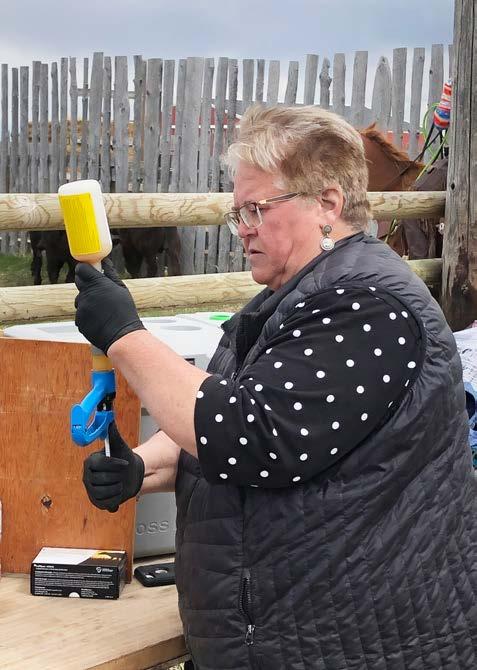

Food safety, animal welfare, and meat quality are all impacted by injections. Improper injection methods or inadequate equipment can cause tissue damage and result in carcass trim or possible chemical residue in meat. The injection process should not cause broken needles, which pose a serious food safety risk.
Injections should be given in the neck, preferably subcutaneously when both intramuscular and subcutaneous methods are listed on the product label. Do not administer drugs by routes other than those recommended by the manufacturer or your veterinarian, as this can cause adverse reactions or impact withdrawal time. Limit injections to 10 cc per site, or as per label instructions.
ORAL
Animal health products and medications can be delivered to animals through feed or water additives. A treatment record must be created for animals exposed to medicated feed or water and withdrawal dates calculated.
Recommended injection sites, to prevent carcass damage and optimize beef quality, pictured below.

It is best practice to use detectable needles. Producers should also be knowledgeable about when to use different gauges and sizes of needles.
If treating animals that are sick, use individual needles to reduce the spread of disease. Needles can be re-used when performing routine vaccinations on a group of healthy animals, but it is necessary to check the needle after every treatment: if it is bent or burred, replace it. Whether or not there is visual damage, needles should be replaced regularly—usually every 10-15 head. Sharp needles reduce the risk of breakage and muscle damage. If a needle breaks and isn’t recovered, record the incident as a permanent record and make sure this record follows the animal throughout its life cycle.Make sure this record follows the animal throughout its lifecycle.
When using a remote delivery device, such as a dart gun, be sure to check the delivery apparatus after each treatment to make sure the needle is still attached. If the needle can’t be recovered, it must be assumed to have broken off in the animal. The convenience of remote delivery devices should be considered in balance with potential risks; such as broken needles, damage to meat quality, and potentially altered drug withdrawal times.
Recommendations to minimize injection impacts:
Visually inspect the needle after each use
Use only sharp needles, not dull or burred
Change needle after 10-15 injections
Discard bent needles (don’t attempt to straighten)
Use appropriate length and size for product viscosity and delivery route
Use highly detectable (HD) needles
Discard of used needles safely (sharps container)
Implants are commonly used to improve feed efficiency and/or increase weight gain. They are typically administered beneath the skin on the back side of the middle one-third of the ear; but be sure to follow manufacturer instructions for best placement.
Animal health products can be applied topically as liquids, powders, or pastes. Parasite control treatments are the most common topical products; typically applied in a narrow strip along the dorsal midline from the withers to the tail head. Product applicators vary between brands, but are usually designed for multi-dose delivery. Be sure to follow manufacturer label directions and record these treatments and their associated withdrawal time.
Cattle oilers provide another means for topical application of insecticides. Only approved products are to be used, with inert oils (mineral, vegetable) as carriers. Do NOT use petroleum products such as diesel, kerosene or used oil; they present a food safety risk due to unknown withdrawal dates and potential chemical residue.

Lack of understanding of issues arising from use of products or delivery methods.
Awareness of the potential issues, adapting better practices going forward.
Appropriate use, verbal protocols; explained; records complete
Appropriate use indicated, written protocols to assist in training and quality assurance; records complete.


Intranasal treatments are most commonly used in younger animals to vaccinate against bovine respiratory disease. These products are administered in either one or both nostrils using a disposable cannula on a syringe. Always follow manufacturer label or vet directions and log treatment(s) in animal health records.
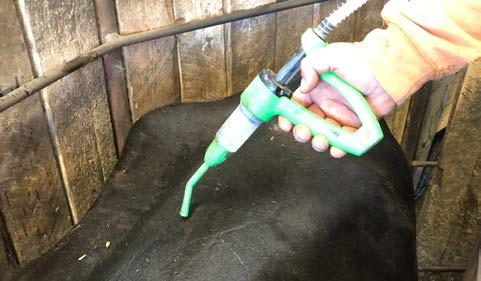




Cattle are monitored regularly to assess health, safety and body condition.

Regular inspection of all cattle and their facilities is necessary to ensure good herd health. It is important that personnel are well trained to identify injury, distress, and abnormal behaviour in cattle. Specialized skillsets are required in different production scenarios; for example inspection criteria for feedlot cattle differs from that of calving cows. All personnel should be capable of monitoring cattle for lameness, disease symptoms, or changes in body condition score (BCS) and hair coat.
The cattle environment must also be checked. Feed and water resources should be available according to the animal’s changing needs and environmental conditions. Cattle that are not fed adequately will lose body condition, will not perform to their capacity, and are more likely to have reduced immune function and reproductive performance. Signs that cattle are not able to access sufficient feed or water include increased vocalization, roaming, and breaking through fences. Cattle should be kept in safe locations where they cannot access chemical residues or other potential toxins.
Cameras or other technology can be used to augment on-the-ground inspection of confined cattle, while those on pasture or housed in larger tracts may be monitored by personnel in trucks, off-road vehicles, on horseback, or using drones or GPS tags.



Routine animal inspection procedures, outlining how producers go about regularly checking their herds, should be documented and include a plan for when problems arise.

Cattle tend to move around regularly. If an animal is stationary for a long time, displaying an unusual posture, limping, or otherwise having trouble moving, it should be carefully examined. The producer should attempt to determine the cause of lameness (injury, infection, or both) and respond with the appropriate intervention or treatment.
Healthy cattle have full hair coats. If an animal has a dull or sparse coat, this may indicate a nutritional problem requiring further investigation of the animal or its feed. Hair loss in cattle can also be attributed to parasites or contagious fungal infections (i.e.: ringworm) which may require medical treatment.
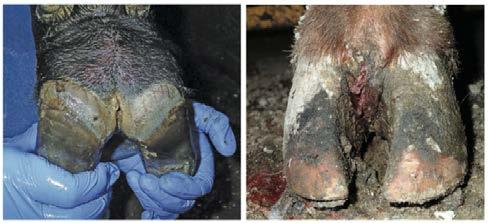
Typical disease symptoms in cattle are lethargy, refusing feed or water, runny eyes and nose, and coughing. Protocols for common diseases should be discussed in consultation with your veterinarian.
If abnormal symptoms (i.e.: high abortion rates, neurological symptoms) or suspected reportable diseases (i.e.: anthrax, Johne’s) are observed, producers should work closely with their veterinarian to diagnose and determine the appropriate course of action.


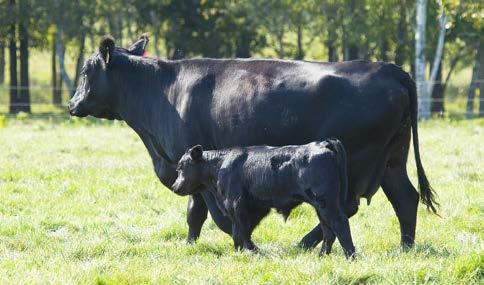
Calving livestock should be checked frequently. The definition of “frequent” must be appropriate for your operation, with consideration for the season and environmental/weather conditions.


Any problems with calving should be dealt with promptly to enhance calf and dam survival, and producers should understand the importance of colostrum management.

Cattle in feedlots require intensive and continued monitoring for diseases such as Bovine Respiratory Disease (BRD), digestive disorders, lameness and other animal health issues found in confined cattle operations.

Protocols should be in place for diagnosis, treatment, and management of common feedlot ailments. (See also Section 6.B: Common Health Conditions in Feedlot Cattle.)
Body condition scoring is a common hands-on assessment protocol used in the cattle industry. BCS helps assess if nutritional needs are being met, or if cattle are in good health.
Ideal body condition scores vary depending on the animal’s stage of production. Animals that are thin are assigned a BCS of less than 2 out of 5; those that are too fat are assigned a BCS of 4 or greater. Ideal condition is typically described as BCS 3. BCS is designed to evaluate mature cattle, so is of little use for cattle under one year of age.
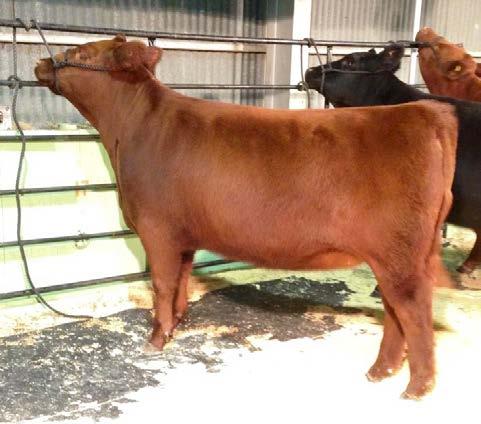
BCS evaluation enables producers to optimize feed resources and animal productivity. Low body condition score can negatively impact animal performance, and may be caused by poor access to feed (i.e. overgrazed pastures or drought conditions), poor feed quality, insufficient bunk capacity, disease, lameness, or inadequate water access.

Tethered or haltered cattle must be checked regularly to ensure they have access to feed, water, and are not tangled or choking.
More information on BCS is available from the Beef Cattle Research Council.

Please choose one of the two self-assessments based on your production model. Only one self-assessment is required.
Beef Cattle Research Council has many decision making tools to assist producers in determining economic benefit.
To see the full version of the Body Condition Scoring tool, please visit www.beefresearch.ca from your tablet or personal computer.

Sample templates are provided in the Producer Reference Manual.

For blank templates of these records, please visit verifiedbeef.ca
Lack of understanding of the importance of regular monitoring and evaluation.
Awareness of monitoring, applied to all aspects of the production cycle, some awareness of reportable disease, intention is to improve on processes or protocols.
Able to articulate and implements plan for monitoring and evaluation of cattle for disease and understanding of reportable diseases.
Written protocols/procedures and plans on herd monitoring. Reportable disease protocol and written and documented training records available. Veterinarian consultation/input at all phases of production cycle.

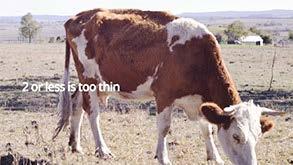
Lack of understanding of the importance of regular monitoring and evaluation.
Must have a plan for monitoring of livestock for early detection of disease, prompt treatment and response to therapy.


Managing all disease conditions using veterinarian developed protocols and management recommendations for prevention and monitoring for effectiveness of therapy.
Manage risk of disease by buying calves of known source, vaccination and health status. On arrival protocols are implemented. Observation and monitoring based on risk profile of cattle and behavior (feeding etc.) Written protocols and plans available and records of implementation. Documented training of staff on protocols, management plans and record keeping requirements.
VERIFIED BEEF
SIMPLE. PRACTICAL. TRUSTED. www.verifiedbeef.ca

DATE : GROUP OR PEN : OTHER :
October
ANIMAL HEALTH PRODUCTS
VACCINATION :
VACCINATION :
PARASITICIDE : ANTIBIOTIC : PAIN MITIGATION :
DOSE AND ROUTE :
DOSE AND ROUTE : DOSE AND ROUTE : DOSE AND ROUTE :
DOSE AND ROUTE : DOSE AND ROUTE :
OTHER PROCEDURES : CASTRATION DEHORNING IMPLANT BRANDING
PEN OR HERD ANIMAL HEALTH TREATMENTS OPTIONAL
WITHDRAWAL TIME : WITHDRAWAL TIME : WITHDRAWAL TIME : WITHDRAWAL TIME : WITHDRAWAL TIME : DOSE AND ROUTE :

VERIFIED BEEF
SIMPLE. PRACTICAL. TRUSTED. www.verifiedbeef.ca
INDIVIDUAL OR GROUP
YEAR :
2021
J une 29 , 2021 North
Exposure to Pesticide sprayed canola crop
Flea Beetle eliminator
Cattle grazed canola overnight. Field had been sprayed day before
OPTIONAL
1 20 C ows With calves
3 herd bulls
VETERINARIAN CONTACT :
J ohn Doe (producer) contacted Dr. Veterinarian who then called C gFARAD(Canadian Global Food Animal Residue Avoidance Database)

ACTIONS / TREATMENTS TAKEN
Removed cattle from crop. Returned to pasture. Monitor for affects to the central nervous system. Some animals may not be able to travel for water/feed. Some may experience shortage of bre ath or inability to breathe. Handle with extr eme care. No treatment is available. First 24 to 48 hours is c ri tical. Must be prepared to euthanize as necessary.
VETERINARIAN CALCULATED WITHDRAWAL DATE :
COMMENTS :
EXAMPLES :
CgFARAD recommends 120 days meat withdrawal
Withdrawal Date: Oct 20, 2021
Herd broke through the fences and entered the field. Spraying w as just Completed when cattle broke in unnoticed until next day
EXPOSURE MODE: Ingested, Inhalation, Spray, Wet-skin Contact EXPOSURE TYPE: Herbicide, Pesticide, Petro-chemical, Anti-freeze
VERIFIED BEEF SIMPLE. PRACTICAL. TRUSTED. www.verifiedbeef.ca

INDIVIDUAL OR GROUP
YEAR :
March 31, 2021 213-Green tag-Pen 11
Improper injectio n site
PRODUCT NAME :
C e t iofur Crystalline Free Acid Suspension
I M injection on left hand side of neck instead of base of ear
OPTIONAL
VETERINARIAN CONTACT :
D r. Veterinarian was contacted by John Doe (producer)
ACTIONS / TREATMENTS TAKEN
Withdrawal time was established at 100 days, but when animal is harvested there can be trim around the injection site required. Harvest the animal for home use, advise the packer to take extra precautions to ensure safe meat . Book harvest date in September.
VETERINARIAN CALCULATED WITHDRAWAL DATE :
COMMENTS :
EXAMPLES :
Dr Veterinarian contacted CgFARAD and established the withdrawal time required.
EXPOSURE MODE: Ingested, Inhalation, Spray, Wet-skin Contact EXPOSURE TYPE: Herbicide, Pesticide, Petro-chemical, Anti-freeze
VERIFIED BEEF
SIMPLE. PRACTICAL. TRUSTED. www.verifiedbeef.ca

INDIVIDUAL OR GROUP
YEAR :
2021
DATE : GROUP OR PEN : OTHER :
A p r i l 1 , 2 0 2 1 R e d T a g 1 2 1
I n j e c t i o n E r r o r
PRODUCT NAME :
F l o r f e n i c o l / F l u n i x i n M e g l u m i n e C o m b o
DOSE/ROUTE :
D o s e o n l a b e l - g i v e n I M i n s t e a d o f S C
OPTIONAL
VETERINARIAN CONTACT :
J o h n D o e ( p r o d u c e r ) c o n t a c t e d D r V e t e r i n a r i a n w h o t h e n c a l l e d C g F A R A D
ACTIONS / TREATMENTS TAKEN
W i t h d r a w a l t i m e e s t a b l i s h e d a t 1 8 0 d a y s , m a y b e e x c e s s t r i m a t h a r v e s t s u r r o u n d i n g i n j e c t i o n s i t e W i l l h a r v e s t f o r h o m e u s e , a d v i s e t h e p l a n t t o o b s e r v e i n j e c t i o n s i t e H a r v e s t a n y t i m e i n O c t o b e r
VETERINARIAN CALCULATED WITHDRAWAL DATE :
COMMENTS :
EXAMPLES :
C g F A R A D d e t e r m i n e d t h e w i t h d r a w a l d a t e a n d s a f e t o h a r v e s t d a t e a s O c t 1 , 2 0 2 1
EXPOSURE MODE: Ingested, Inhalation, Spray, Wet-skin Contact EXPOSURE TYPE: Herbicide, Pesticide, Petro-chemical, Anti-freeze
VERIFIED BEEF
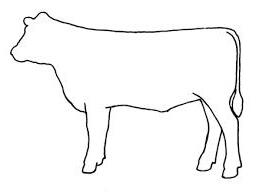

SIMPLE. PRACTICAL. TRUSTED. www.verifiedbeef.ca
FARM NAME OR OWNER:
DATE OF INJECTION : ANIMAL IDENTIFICATION :
January 1, 2021
178G
PRODUCT USED : WITHDRAWAL CHECK AT SHIPPING :
(Brand Name)
DESCRIBE HOW ANIMAL IS PERMANENTLY IDENTIFIED :
DISPOSAL OF ANIMAL
December 1, 2021
DATE :
December 5, 2021

Red dangle tag in right ear (178G), Left ear has CCIA# 123456789 - Black White Face cow x
SOLD TO SLAUGHTER PLANT SLAUGHTERED FOR OWN USE DIED ON THE FARM
OTHER :
DATE INFORMATION SUPPLIED TO NEXT OWNER / BUYER :
Mr. Packer ( Olds, AB )
December 1, 2021
WHO WAS CONTACTED : PERSON SUPPLYING INFORMATION :
J ane Doe
INFORMATION SUPPLIED BY (CHECK ONE OR MORE) PHONE FAX OTHER :
LOCATION OF BROKEN NEEDLE FRAGMENT (PLEASE MARK WITH AN ‘ X ’)
VERIFIED BEEF
A BC Ranch (John Doe)
SIMPLE. PRACTICAL. TRUSTED. www.verifiedbeef.ca


